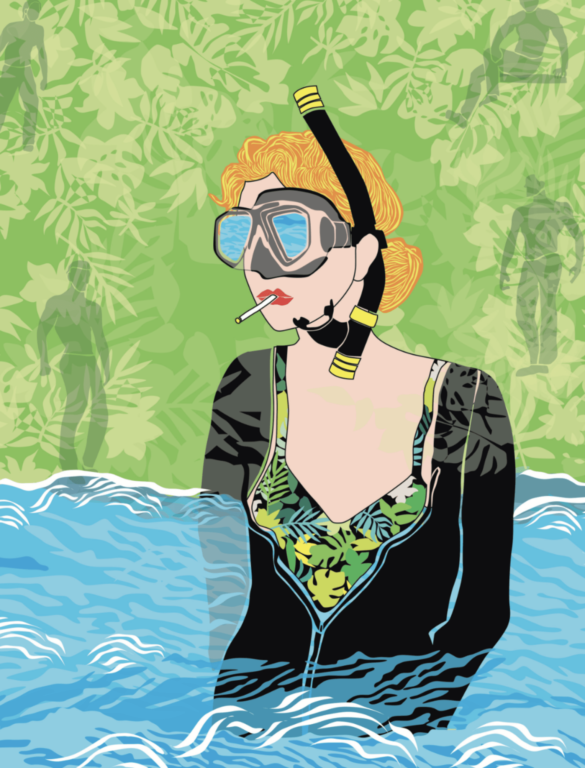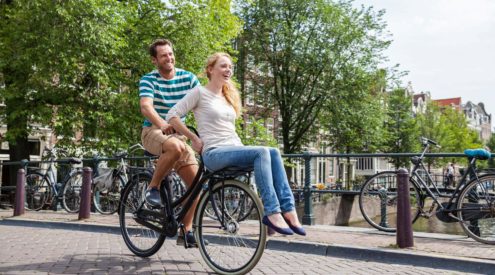In the year 2000, a Very Bad Habit deposited one intrepid journalist on coral islands in the Pacific, among 32 of the fittest humans on the planet.
Saturday night, 1980s Pretoria. The cinema screen comes to life, triumphant music heralds realities way beyond my land-locked ken. Surfskis. Glittering Monte Carlo streets. Tight, sun-washed linen shorts and deck shoes, catamarans and golden skin. Golden tobacco too, sending elegant curls of vapour skywards as the sun rose, or set, or cocktails were served.
For decades, dastardly Big Tobacco sold dreams as efficiently as any Apple or Nike. Their aspirational domain, wisely chosen, was international travel – still a way off the indignities of mass transit as we know it today.
At a very impressionable age, Peter Stuyvesant was the Caribbean to me: that ‘beautiful, bright, light world’ where the language of life is pleasure and ‘ultra-luxury yachts [are] the toys of tycoons’. Open skies, canyons, cowboys? ‘Come to Marlboro Country’ was a genius line, an irresistible call to escape (not if you wanted to escape suburban braais though. Cowboys would probably still braai, a lot). And Camel, well, Camel barely bothered with words. The ads glorified the solo adventurer, strung about with accoutrements such as a coil of rope, a sweaty khaki shirt and stubble. Also, a lighter! Matches get wet.
All this subliminal messaging didn’t have much effect through school, university and the first few years of work: I remained a resolute non-smoker. But by the time my boyfriend and I scooted off to Brazil, woefully under-resourced, buying a loose cigarette and a box of matches adorned with foreign script was already a mini-ritual upon entering a new city. A way in, much like a coffee is now.
A year or so later, and the buggers had me by the throat.
Which, I think, is in part why the youth culture magazine I worked for suggested me and my nicotine-stained fingers when invited to send a journalist on the last Camel Trophy of the millennium.
It was an insane assignment: fly CT-JHB-Perth-Sydney-Auckland-Nuku‘alofa, capital of Tonga, on the island of Tongatapu and just about as far away as a person can get from anywhere. Tonga is the first place to see dawn steal over the Pacific each day. It has never been colonised and back then had a roly-poly 82-year-old king at the helm.
Its glistening collection of coral islands was to be the athletic playground for teams from 16 countries to prove their spirit and physical and mental prowess. All competitors had to be amateurs; there was no cash prize for winning.
The Camel Trophy turned 20 in the year 2000. Times were changing, if not particularly rapidly on Nuku’alofa. Here, markets offered up yams and coconuts and bananas, displayed in large woven baskets. Women attired in mat-like palm-leaf skirts had their feet solidly planted on the coral sands. Tongans were a godly people, leaving nightlife to the tourists who came to drink and swim and screw (although like all nations, it appears, a local sedative can be found, kava root).
Slowly, slowly the seas were grinding coral reef and volcanic stone into perfect sand. Blowholes on one side of Tongatapu spouted like whales, palm trees waved to us – and were woven into décor that adorned the streets for the king’s birthday. A respectable number of the island’s roaming porkers were turned into golden suckling pigs for the occasion.
King Tupou IV himself, propped up on crutches, sounded the start of the Trophy, the most demanding orienteering race on the planet.

Illustration: Jess Nicholson
The low-down: teams of two had to find more than 320 location markers hidden on jungle islands and under seas as quickly as possible, using scuba gear, snorkels, mountain bikes or whatever it took. They drove a banana-bright flotilla of rigid inflatable boats (as opposed to traditional 4x4s) around the dotted islands. And there, for a few blissful days, was I, perched atop the SA team’s boat, occasionally allowed to idle slowly in circles while Wim van Herzeele and Xavier Scheepers galloped up a volcanic island. They won hands down, by the way.
Do I need to say the chiselled twosome didn’t smoke? Me and my guilty habit were alone, forbidden to light up thanks to fuel in the RIB tanks. Sometimes I would stand in chest-deep water to feed the demon. Many years later, that’s what eventually helped me give up the ciggies: the memory of the ash and its 7 000 chemicals floating off into a pristine sea. Sies.
The trip underlined a suspicion I have about travel. There is the perfect jelly-tot of an island, hazy with beauty, and it radiates joy. But there is also the zing of a salt-encrusted coral scratch on sunburned skin. The memory of a crazy hours-long sea crossing on a rainy day, “dry suit” a misnomer, spine juddering as the RIB crashed from wave to trough, again, again. Awkward gifts of spaghetti and firewood donated to us by dirt-poor Tongans. Squeezing into a wet sleeping bag on a chilly beach. Then the sun coming out, and a posse of flying fish overtaking us on a smooth sea.
An edge is wonderful for travel, as the Camel Trophy blokes knew so well. Nearly one million people applied to compete in the late 1990s. But 2000 was to be the final event: sponsors were hard to find; advertising soon impossible for the Camel brand, even disguised as a clothing company. Now, just fan clubs remain. Still, the event’s success is a reminder to all travellers: pillow menus and tasting menus may have their place. But add a dollop of adrenaline? That’s what makes the memories.
A version of this article appeared in the November 2022 print issue of Getaway.
By Janine Stephen
Follow us on social media for more travel news, inspiration, and guides. You can also tag us to be featured.
TikTok | Instagram | Facebook | Twitter
ALSO READ: The healing: a yoga retreat gone wrong

















